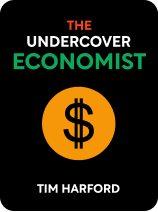

This article is an excerpt from the Shortform book guide to "The Undercover Economist" by Tim Harford. Shortform has the world's best summaries and analyses of books you should be reading.
Like this article? Sign up for a free trial here .
How does the American health care system work? How does it differ from the systems in other developed countries? And why are so many Americans dissatisfied with the way it functions?
Unlike most developed countries, the United States does not provide free health care to the population. Instead, American citizens are covered by either private or public health insurance, or a combination of both.
This article takes a look at the main problems with the health care system in the United States and lists several ways it could be fixed.
Health Care in America: Expensive, Bureaucratic, and Patchy
The United States has a large health insurance problem. Only 17% of Americans are happy with the healthcare system and believe it requires no changes. In many other countries, buying healthcare is compulsory, and how much you pay for your healthcare depends on how much money you make, not how risky of an investment you are. In the United States, buying healthcare is not compulsory, and when you decide to do so, you pay based on how risky your insurance company thinks it will be to cover you.
The health care system in the United States has three major issues. It’s expensive, bureaucratic, and patchy.
- Expensive: Based on some measures, the United States has the most expensive healthcare system on earth. The English government pays less than the United States government per person in healthcare costs, and they cover everyone for free, while the U.S. only covers seniors through Medicare and those who are disadvantaged through Medicaid.
- Bureaucratic: Because the system is so disorganized, a lot of the costs that Americans incur are bureaucratic. Administration costs are about $1000 per person per year in the United States. This is more than the Czech Republic and Singapore spend in total, and they have similar health outcomes to the United States (Singapore is a bit better, the Czech Republic is a bit worse). In Canada, administrative costs are only $307 per person per year, and their health outcomes are much better. A lot of bureaucracy comes from health insurance companies trying to find out how risky their potential customers are.
- Patchy: In the U.S., health insurance is regularly tied to employment. Employers provide a list of potential plans from which employees must choose. This does make people with a job more likely to buy into the healthcare system. But asking Human Resources managers to narrow down healthcare options for their employees makes no sense. Lazy HR managers often choose bad packages, which results in more spending at a lower quality. And for people without a job, they’re essentially on their own. 15 percent of Americans don’t have health insurance, which should be a shocking number. In Germany, only 0.2 percent of citizens are uninsured, and in Canada and Britain, everyone is insured through the government. On top of all of this, people are less likely to leave their jobs unless they can line up other health coverage. This slows down innovation and economic growth.
Government Failures
While the United States has a poor, market-based health insurance system, those run by governments have their own issues. Take England as an example. The system is often overcrowded, there are long lines for resources, and there isn’t much patient choice. The survey that found that only 17% of Americans are pleased with the healthcare system found that only 25% of people in England are happy with their system, which is run by the National Health Service (NHS).
The National Institute for Health and Care Excellence, or NICE, makes a lot of decisions within the NHS. And they are not always popular ones. The Royal National Institute of the Blind, for example, is angry with NICE for being unwilling to approve photodynamic therapy, a treatment that can make eye problems much better. NICE has agreed only to allow for photodynamic therapy to be covered by the NHS in extreme cases, and even in those cases, only in one eye.
The challenge for NICE is that the NHS has limited resources. It’s difficult to determine how to allocate those resources, and from there how to decide which procedures or treatments to allow for. NICE calculates what is “worth it” through a system called Quality-Adjusted Life Years, or QUALYs. A procedure will have a better QUALY score if it solves a medical problem for 10 years rather than one, for example. The National Institute for the Blind might argue that being blind is a debilitating condition to get NICE to approve photodynamic therapy. But if it’s so bad already to be blind, then the National Institute for the Blind is arguing that blind people’s lives matter less than the lives of people with vision. In this scenario, if a blind person develops a heart condition, they’ll be lower on the priority list than people with vision who have heart conditions. The National Institute for the Blind can’t argue that being blind is debilitating without driving the QUALY score for non-vision-related operations for blind people way down. It’s a classic Catch-22.
Fixing Healthcare Systems
To solve the problems with healthcare in market-based and government-based systems, we need to target problems directly and precisely. There are four potential failures in the healthcare system: scarcity power, externalities, fairness, and imperfect information.
1. Scarcity Power: The healthcare industry doesn’t have a big scarcity issue. Mostly, especially in the developed nations we are discussing, there are enough doctors and treatment options.
2. Externalities: Externalities are only a problem in specific cases, like the transmission of a disease like HIV/AIDS. The solution is simple—introduce some regulatory oversight and subsidies to boost inoculation rates.
3. Fairness: Fairness is not a specific market issue, but it’s still something to be concerned with because we don’t want to deprive the poor of health coverage. We can solve the fairness issue in healthcare by using the “head start” strategy and redistributive taxes discussed in previous chapters. If we can solve poverty issues, we can solve healthcare issues.
4. Imperfect Information: This is the biggest market problem. While a government takeover of the industry might seem appealing, as the issues in England show, this won’t solve the problem according to Harford. For this issue, a two-part treatment is necessary.
First, make healthcare information widely available. It should be easy to get second opinions, call helplines, find verified information online, and we should be providing informational services in places like grocery and drug stores.
Second, let patients use the new information that they have. Currently, either an insurance company or the government is making a lot of choices on a patient’s behalf. The best system would have patients pay for most of their choices, but leave the big bills to the government or private insurance. Rather than having health insurance for everything, we should have only catastrophic health insurance, which would cover large procedures or accidents. Data shows this type of insurance is about $1500 per year per person cheaper for the government or insurance companies. Citizens should be mandated to put this extra $1500/year in a savings account that can cover smaller health costs. If they don’t incur a lot of health costs, their money in the account will grow, and if they die with money in that account, they can pass it off to their children. Singapore uses this system and has been successful with it.
Moral Hazard
One final problem with insurance, in general, is how it changes people’s behavior. If your car is insured against theft, you’ll be more likely to park it on the street, whereas if it isn’t, you might be willing to pay for a car lot. This is called a moral hazard.
For example, moral hazards are inherent in public unemployment insurance. When people have unemployment insurance, they’re less motivated to find a new job. But as a society, we don’t want people to starve. So we’re left, once again, with a trade-off—incurring some moral hazard is necessary in a benevolent society. The government tries to solve this problem by only giving unemployment insurance to people who are actively looking for a job. But it’s impossible to monitor exactly how motivated someone is in their search, so we’re left with imperfect information.
Imperfect information also affects how people are paid. There is a reason year-end bonuses are generally only a small part of someone’s overall salary. If a boss could tell exactly how hard everyone was working at all times, he could pay people only based on their performance. But once again, this is impossible, so people are paid a base salary and then sometimes receive a bonus for exemplary performance.

———End of Preview———
Like what you just read? Read the rest of the world's best book summary and analysis of Tim Harford's "The Undercover Economist" at Shortform .
Here's what you'll find in our full The Undercover Economist summary :
- How to think like an economist
- How to use principles like scarcity, price targeting, the stock market, and game theory to make better decisions every day
- Why the economy is mostly about people, not complex math, graphs, or jargon






